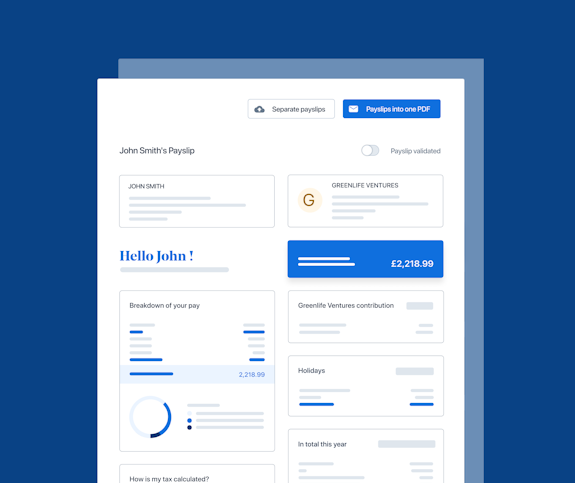- Blog
- |People management
- >Employee wellbeing
- >Employee wellness programs explained
Employee Wellness Programs: An Explainer for UK Employers


Employee wellness programs, also referred to as company wellness programs, are no longer just a trendy post-pandemic retention tactic. They’re a critical piece of the engagement puzzle in any thriving workplace.
Increasingly, HR managers and leaders across the UK are awakening to the importance of these programs and the key role they play in fostering a positive work environment, enhancing employee satisfaction, and boosting the bottom line.
In this article, we’ll uncover the nuts and bolts that make up a sound employee wellbeing program, what policies are most effective, and offer practical ideas for implementation.
What is wellbeing in simple terms?
It’s simple; workplace wellbeing is really just about being comfortable, healthy, and happy at work.
For employees, that involves peak physical, mental, and emotional health, as well as discovering a sense of purpose and fulfilment on the job. Effective worksite wellness programs aim to support all of these dimensions, ensuring that employees feel valued and supported in their work.
What does wellbeing mean in the workplace?
It all boils down to creating an environment where employees can thrive. Wellness in the workplace involves providing adequate support for physical health through fitness programs, mental health, and fostering a positive work culture that encourages the work-life balance so key to sustainable performance. Wellbeing programs for employees are designed to address these areas and more, helping employees stay healthy, happy and engaged.
What are the models of wellbeing at work?
Just like any positive change, there’s a science to it. There are many models which can guide the development of your staff wellbeing programs. Some of the most recognised ones include:
The Five Ways to Wellbeing
This model, developed by the New Economics Foundation, includes five key actions: Connect, Be Active, Take Notice, Keep Learning, and Give.
PERMA model
The brainchild of leading psychologist Martin Seligman, this model focuses on Positive Emotion, Engagement, Relationships, Meaning, and Accomplishment.
The Job Demands-Resources model
This framework emphasises balancing job demands with available resources to reduce stress and enhance wellbeing.
What are some ideas for employee wellness programs?
Developing any kind of employee wellness policy will require your team to get their thinking caps on. What are the most effective strategies and initiatives that can help your employees to feel better and more resourced at work? Here are some ideas to consider:
Flexible working hours
Allowing employees to adjust their working hours can help them manage personal commitments and reduce stress.
Mental health support
Implementing an employee assistance programme (EAP) can provide confidential counselling services, helping employees cope with personal and professional challenges.
Fitness programs
Offering discounted gym memberships or on-site fitness classes encourages physical activity.
Healthy eating initiatives
Providing healthy snacks and promoting balanced meals can improve overall health.
Stress management workshops
Offering training sessions on stress management techniques can help employees handle pressure more effectively.
You can discover more ideas and strategies in our post on how to implement effective wellbeing programs for employees.
What is a wellbeing allowance in the UK?
A wellbeing allowance is a financial benefit provided by employers to support employees’ health and wellness activities. In the UK, this allowance can be used for various purposes, such as to cover gym memberships, fitness classes, or wellness retreats. This flexible benefit enables employees to choose the wellness activities that best suit their needs, promoting a more personalised approach to health and wellbeing.
What is the employee assistance programme in the UK?
If you want to go a step further in your efforts then you can implement an Employee Assistance Programme (EAP). This is a service that provides confidential support to employees dealing with personal or work-related issues. In the UK, EAPs typically offer counselling, legal advice, and financial guidance, helping employees manage stress and maintain a healthy work-life balance.
One-on-one support can be a powerful tool. This service can prove to be a pivotal component of any comprehensive employee health and wellness program.

What are the steps to implement an effective employee wellness program?
Implementing effective wellness policies doesn’t happen overnight - there are several key steps you’ll want to work through:
First, you’ll want to assess your needs
Conduct surveys or focus groups to understand the specific wellness needs and preferences of your employees.
Then set clear goals
Define what you want to achieve with your wellness programs, whether it’s reducing employee turnover, improving job satisfaction, or enhancing productivity.
Develop a comprehensive plan
Create a detailed plan that includes various wellness initiatives, timelines, and responsible parties.
Communicate effectively
Ensure that employees are aware of the available wellness programs and how they can participate.
Evaluate and adjust, the evaluate and adjust again
Regularly assess the effectiveness of your wellness programs and make necessary adjustments based on feedback and outcomes.
What is the staff wellbeing policy?
A staff wellbeing policy is a formal document that outlines an organisation’s commitment to supporting the health and wellbeing of its employees.
This policy typically includes the goals of the wellbeing program, the specific initiatives offered, and the roles and responsibilities of both the employer and employees. Having a clear and well-communicated staff wellbeing policy ensures that all employees ‘get’ what resources are available and how to access them.
The importance of wellness in the workplace
We’ve explored the basic building blocks of employee wellness programs and why these are crucial if your businesses’ goal is to be a thriving and productive workplace.
By addressing the physical, mental, and emotional needs of employees, you’ll be opening the doors to creating a positive work environment that works for your staff members.
For HR leaders, it’s essential to develop comprehensive wellness policies, communicate these effectively, and continuously evaluate their impact on the overall workforce. By doing so, you can enhance employee satisfaction, reduce turnover, and ultimately drive true business success.


A UK 4-Day Working Week - Thoughts On Labour’s Plan

Running payroll - A Guide For New Businesses

The Alabaster Ruling & Maternity Pay - A Guide For Employers

The End Of Zero Hours Contracts? Implications For Businesses

What is the HM Revenue and Customs Starter Checklist

